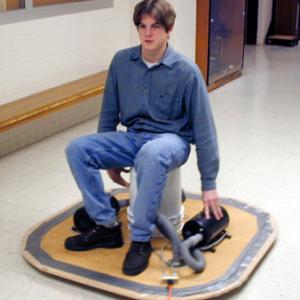College of Liberal Arts & Sciences
2B20.80 - Hovercraft
The hovercraft will work much the same way as the water rocket. In this case you may throw off weights when the craft is running or even more impressive is to use a CO2 fire extinguisher or a compressed air tank to propel the craft. Maximum working load on the craft is about 250 lbs.
- John E. Carlson, "Kick Dis Power Puck", TPT, Vol. 42, #3, Mar. 2004, p.144.
- Thomas B. Greenslade, Jr., "Gyroscopic Control of Hovercraft", TPT, Vol. 31, #1, Jan. 1993, p. 4.
- Sandra K. McPhillips with Maria A. Lynch, "A Tale of Human Power", TPT, Vol. 29, #2, Feb. 1991, p. 82.
- Ken Altshuler, "The Human Airpuck", TPT, Vol. 27, #8, Nov. 1989, p. 615.
- "Build a Leaf Blower Hovercraft", Popular Mechanics, Vol. 196, #7, Oct. 2019, p. 54.
- Sean Michael Ragan, "How To Build A Hovercraft From Styrofoam Plates", Popular Science, Vol. 287, #3, Mar. 2015, p. 65.
- Doug Cantor, "Simple Project of the Month: Build Your Own Hoverpuck", Popular Science, Vol. 284, #4, Apr. 2012.
- David Smith, "Robust Air Puck Takes a Kicking", Physics Education, Vol. 39, #2, Mar. 2004, p. 208.
- William Beatty, "A Demonstration Hovercraft", PIRA Newsletter, Vol. 9, #3 Jan. 1995, p. 24.
- "Conservation of Momentum: Fire Extinguisher and Cart", PIRA Newsletter, Vol. 3, #17, 1/25/90, p. 2.
- "M-282. Human Air Puck", DICK and RAE Physics Demo Notebook.
- 50 Fun Experiments for the Mad Scientist in You, "Hover Balloon", National Geographic Kids, p. 126.
- Bill Franklin, "Student Hovercraft Construction", Teaching About Impulse and Momentum, p. 3.15.
- "Hovercrafts: Boats That Fly on a Cushion of Air", Readers Digest.
- "Earliest Flight by a Hovercraft", Guinness World Records, 2003, p. 145.
- "Largest Civilian Hovercraft", Guinness World Records, 2003, p. 145.
Disclaimer: These demonstrations are provided only for illustrative use by persons affiliated with The University of Iowa and only under the direction of a trained instructor or physicist. The University of Iowa is not responsible for demonstrations performed by those using their own equipment or who choose to use this reference material for their own purpose. The demonstrations included here are within the public domain and can be found in materials contained in libraries, bookstores, and through electronic sources. Performing all or any portion of any of these demonstrations, with or without revisions not depicted here entails inherent risks. These risks include, without limitation, bodily injury (and possibly death), including risks to health that may be temporary or permanent and that may exacerbate a pre-existing medical condition; and property loss or damage. Anyone performing any part of these demonstrations, even with revisions, knowingly and voluntarily assumes all risks associated with them.

